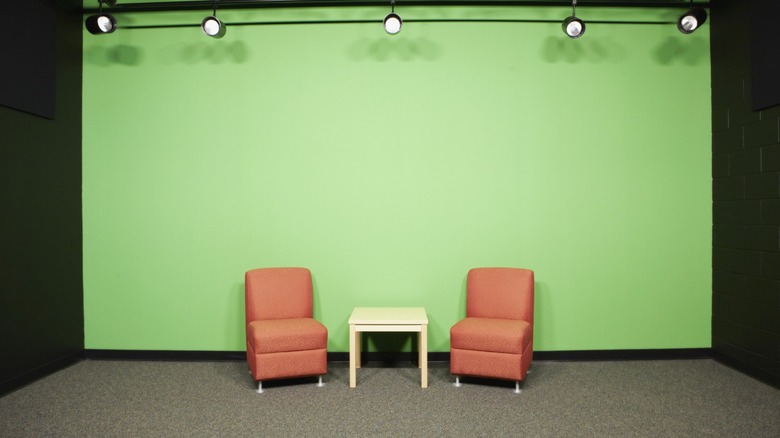Why Are Green Screens Green? Here's How They Work
Movies and TV shows have come a long way thanks to advancements in computer-generated imagery. While it might come as a disappointment to find out that Spider-Man never actually visited space or that the Jurassic Park is barren land for the most part, it is thanks to CGI and other visual effects techniques that allow us to be transported into different realities.
Complex environments can be created digitally, saving not just time but the cost of production. Filmmakers achieve a blend of reality and computer-generated backdrops thanks to a technique called chroma keying. If you've ever seen behind-the-scenes footage of a movie, TV show, or commercial, you have likely spotted giant solid green walls or curtains. These are what are referred to as green screens, and are what allow editors to add in any background to a scene, while retaining the subjects in frame, such as actors.
You can even use the green screen effect on CapCut and other mobile-ready video editing apps. Green screens themselves don't pack in any technology or possess any special traits — other than being perhaps the most distinguishable color on set. If you're curious as to how green screens work, and why they're even green in the first place, give this quick explainer a read.
How do green screens work?
Chroma keying is a feature that editors use in professional grade software like Adobe Premiere Pro, DaVinci Resolve, or Final Cut Pro. It's also available in other budget-friendly video editing programs, thanks to how versatile the tool is. In simple terms, Chroma keying is the process of digitally removing a specific range of colors in a frame, allowing the separation of the foreground and the background. The removed color can then be replaced by any image or video, which is how your favorite actor goes from standing in a four-walled room to catching a breathtaking glimpse over the mountains — aided by an air blower, of course.
The concept of chroma keying isn't exclusive to big budget Hollywood film sets. In fact, you can recreate this at home by familiarizing yourself with some tips and tricks to edit videos on your iPhone. Circling back to the role that a physical green screen plays — it serves as the solid chunk of color that the chroma key tool picks up during post-production. Though most green screens are made out of cloth or fabric for ease of setup and flexibility on set, in theory, anything that's uniformly green in color and expansive enough to function as a backdrop can be used for chroma keying.
But why green?
Technically speaking, the only job of the chroma key utility in a video editing tool is to identify and select a similar range of colors — and you get to pick what color this is. This means you could essentially use any color as a "green" screen and replace it in post, as long as it contrasts well against your foreground. Googling behind the scenes images from your favorite films will sometimes reveal giant blue screens on set, instead of the usual green.
The reason why green and blue screens work best is fairly straightforward. In scenes comprising people, the human skin tone is mostly devoid of bright-green pigments. This means giving the chroma key plugin a less difficult time when distinguishing between what to keep and what to erase. Bright green is also a color easier to avoid in clothing or accessories.
There is also a technical advantage of going with a green screen on sets. Most digital cameras sport a single image sensor and make use of a Color Filter Array (CFA) to gather color information. This filter uses the Bayer Pattern, which is an arrangement where half of the filter elements are green, and the remaining half are split between red and blue. This aligns with how the human vision works, being most sensitive to green. Thus, using a green screen means more detail for the camera, which directly leads to better edge detection — resulting in an efficient keying process.


